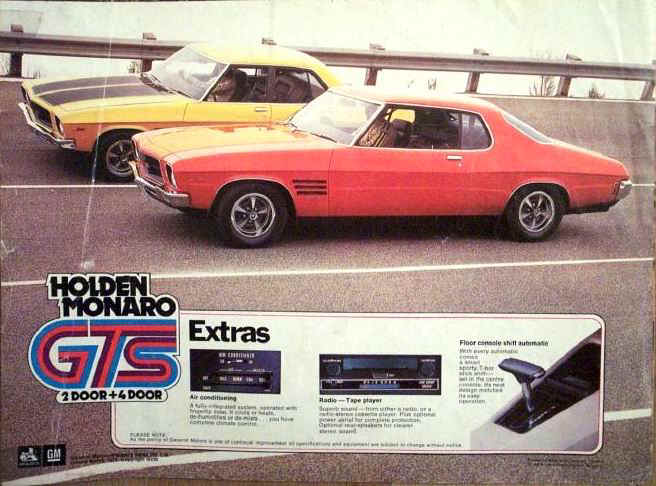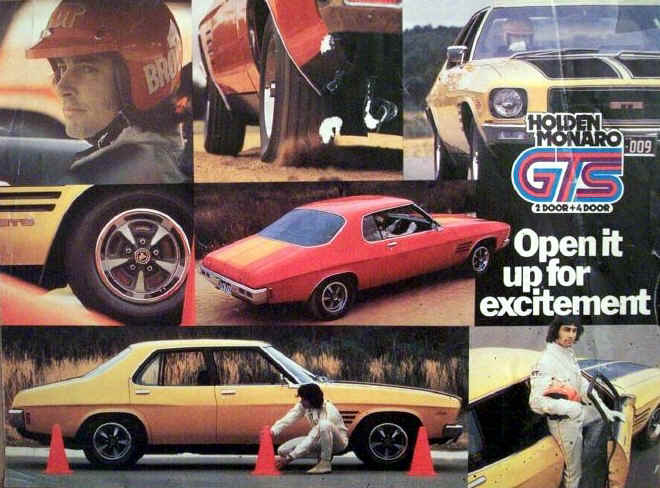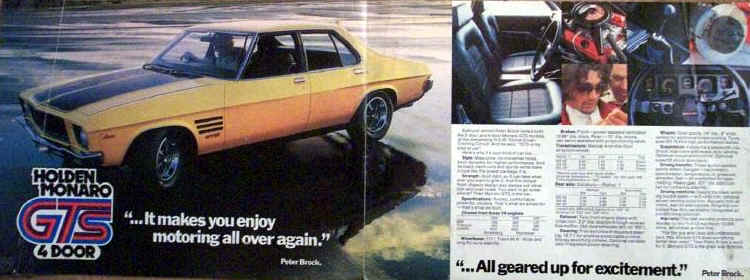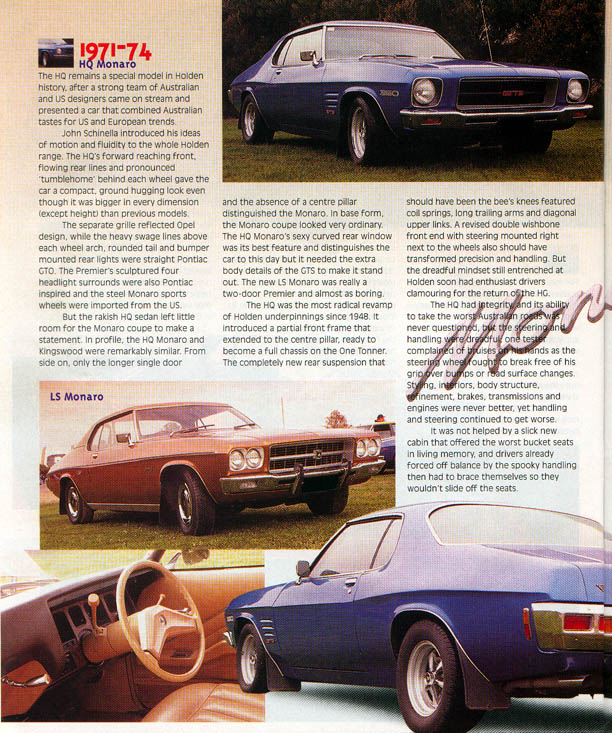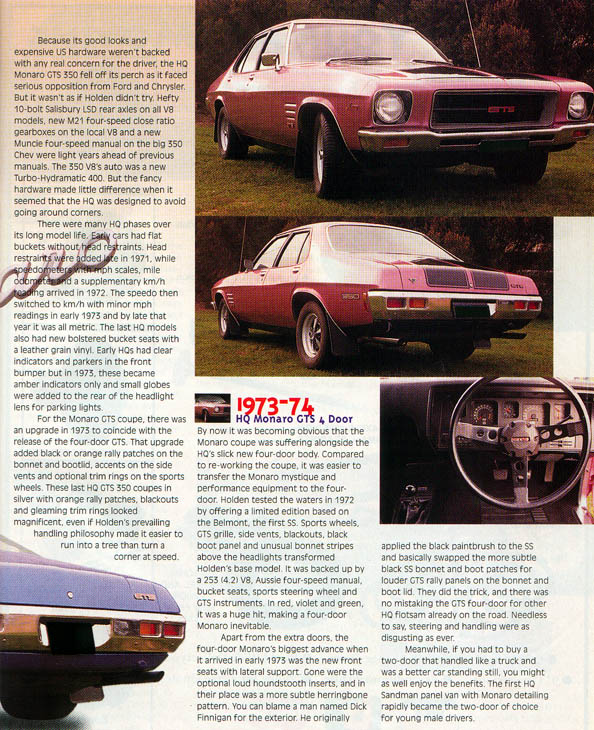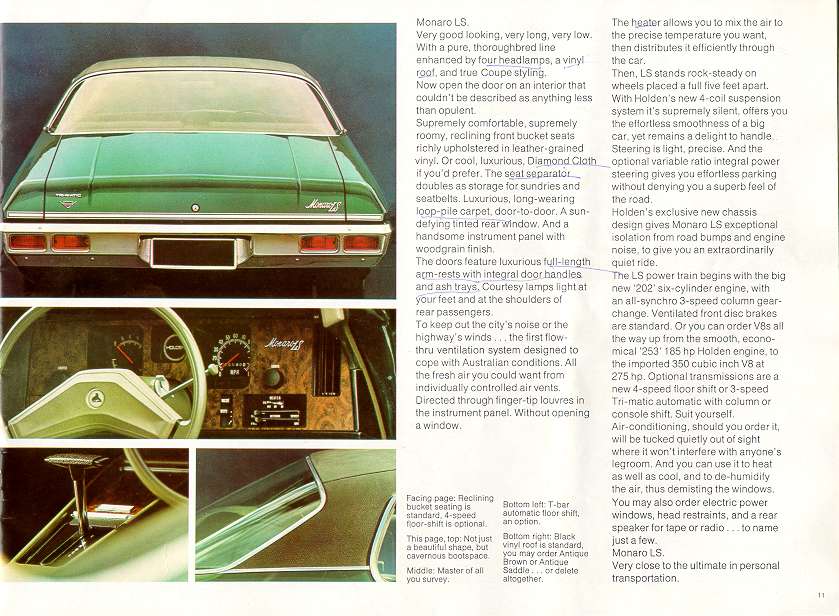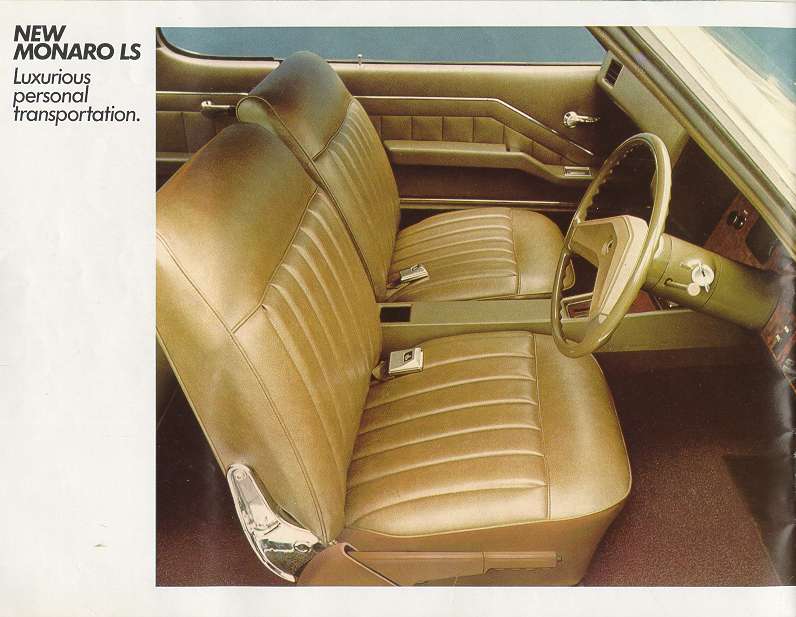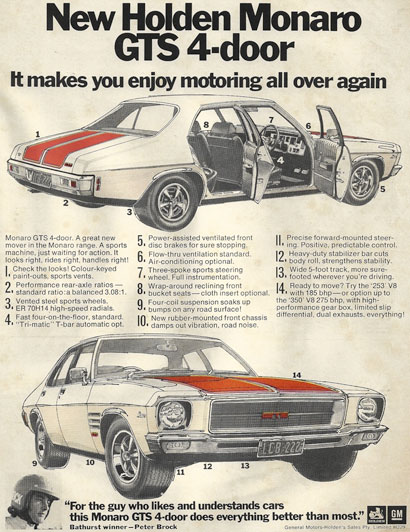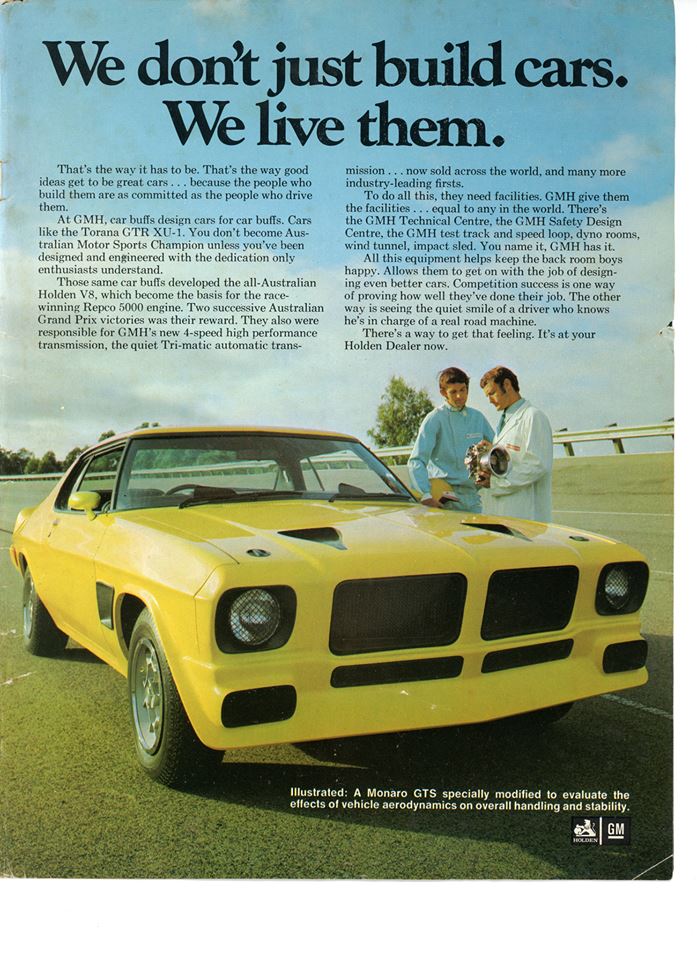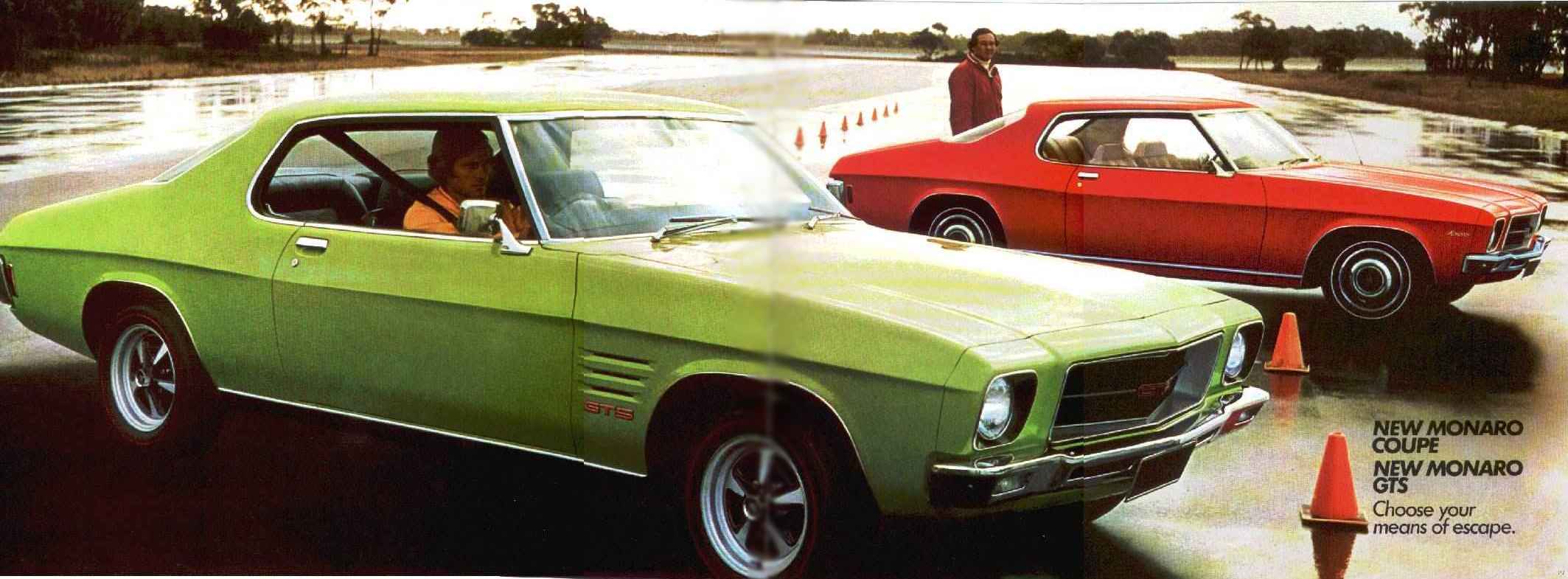
With the HQ series, Holden's design, engineering and manufacturing team delivered the definitive Australian car - new from the ground up and embracing the best of US and European trends.
The HQ's forward-reaching front, flowing rear lines and pronounced 'tumblehome' behind each wheel gave it a compact, ground-hugging look, even though it was bigger than previous models. The separate recessed grille reflected Euro trends while the bulging muscle lines above each wheel arch, the rounded tail and bumper-mounted rear lights were straight Pontiac GTO muscle car.
After it was blacked-out for the Monaro GTS, the HQ's standard silver grille became a road-devouring intake. The Monaro's pillarless coupe roofline and its wrap-over rear window were eye-catching. A new LS - 'luxury and sport' - Monaro with black vinyl roof and dual headlights combined Premier appointments with Monaro style.
The HQ was the most radically new model since 1948, and Monaro shared the benefits. It had a partial front subframe that extended to the centre pillar and a totally new rear suspension. It delivered new levels of structural strength, rough road stability and grip. Further features included a more comprehensive safety package, Holden's first flow-through ventilation, a demisting system, integrated air-conditioning, a new flat dash and slender front pillars for exceptional forward vision.
Holden sixes were also boosted in size, and there were hefty 10 bolt Salisbury limited slip differential rear axles on all V8 models. A new Aussie M21 4 speed close-ratio gearbox could be ordered with the local V8, the big Chevrolet 350 V8 scored a new Muncie 4 speed manual and the 350 was fitted with a Turbo-Hydramatic 400 auto shift.
While Daddy Cool's Eagle Rock topped the charts, Monaro colours came from the 'flower power' palette. They included several purples, pinks, lime and forest greens, acid reds, bright blues, silver and gold.
As the HQ went through several phases over its long model life, the Monaro GTS coupe was upgraded in 1973 to coincide with the release of the four door GTS. It introduced bold new colours, new bonnet and bootlid rally patches, accents on the side vents and optional polished trim rings for the sports wheels.
Holden HQ Monaro GTS 4 Door
1973-74
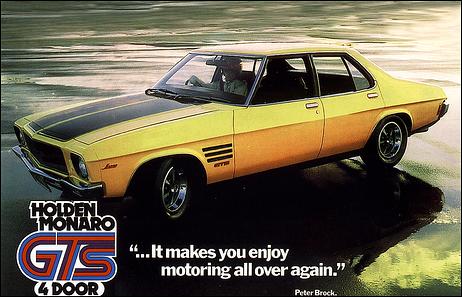
Inevitably, the trendsetting two-door Monaro had such a strong influence on the rest of the Holden range that sedans took on a similarly sleek look. The process began with the HT sedan's 'faster' roofline and became more apparent with the arrival of the fluid HQ. So it was in the course of this model's long-selling life that Holden took the opportunity to test the waters with a four door Monaro.
In 1972, Holden had offered a limited edition sedan based on the entry level Belmont. The first SS, it was transformed by sports wheels, GTS grille, side vents, blackouts, black boot panel and unusual bonnet stripes from the headlights to the front scuttle panel. Backed up by a 253 V8 (4.2), Aussie four speed manual, bucket seats, sports steering wheel and GTS instruments and finished in 'Infra Red', 'Ultra Violet' or 'Lettuce Alone' green, it became a huge hit.
The first four door GTS Monaro arrived in 1973. It featured new contoured front seats, trimmed in a sophisticated herringbone pattern. Black SS bonnet and boot patches were replaced by louder GTS rally panels on the bonnet and boot lid. They did the trick; there was no mistaking the GTS Monaro four door for any other of the 250,000 HQ Holdens already on the road.
By this stage, the Monaro GTS 350 - coupe or four door - became a rarer beast as more Australian drivers opted for the home-grown 308 V8. The final four door HQ Monaro GTS 350 examples still made a fabulous farewell to the Chevrolet small block V8 with Salisbury rear axle, Muncie four speed and 70 series radials.
DATE OF INTRODUCTION
July 1971. Four door sedan - March 1973PRICES AT TIME OF INTRODUCTION
Monaro (2850 cc six & 3 speed manual) - $3120,Monaro LS (3300 cc six & 3 speed manual) - $3570,
Monaro GTS (4.2 V8 & 4 speed manual) - $3720,
Monaro GTS 350 (5.7 V8 & 4 speed manual) - $4630
TOTAL NUMBER BUILT
Monaros: 13,782SS Sedans: 1200 1st build (10c trim, Houndstooth)
SS Sedans: 1600 2nd build (10d trim, Raydo flax inserts)
PERFORMANCE
Monaro GTS 350350 ci (5740 cc) V8
Final drive:3.08:1
Four speed manual
1st (2.52:1):54 mph (86.9 km/h)
2nd (1.88:1):71.9 mph (115.8 km/h)
3rd (1.46:1):94 mph (151.2 km/h)
4th (1.00:1):124.4 mph (200.3 km/h)
Elapsed time 0-100 km/h:8.0 seconds
Standing 400 metres:15.7 sec
MODELS AVAILABLE
up to 30-9-72
HQ81837 Monaro GTS 350
HQ81237 Monaro LS V8 coupe
HQ81137 Monaro LS L6 coupe
HQ80837 Monaro GTS coupe
HQ80437 Monaro V8 coupe
HQ80337 Monaro L6 coupe
HQ80269 SS V8 sedan (Belmont) (Kingswood designation)
HQ80469 Monaro 4 door sedan (Kingswood)
Model option
XV4 Monaro GTS 4 door
XW8 Monaro GTS 350 4 door
from 1-10-72
8M69 Belmont sedan
8N37 Monaro coupe
8P37 Monaro LS coupe
8Q37 Monaro GTS coupe
8Q69 Monaro GTS sedan
8N69 GTS sedan early build
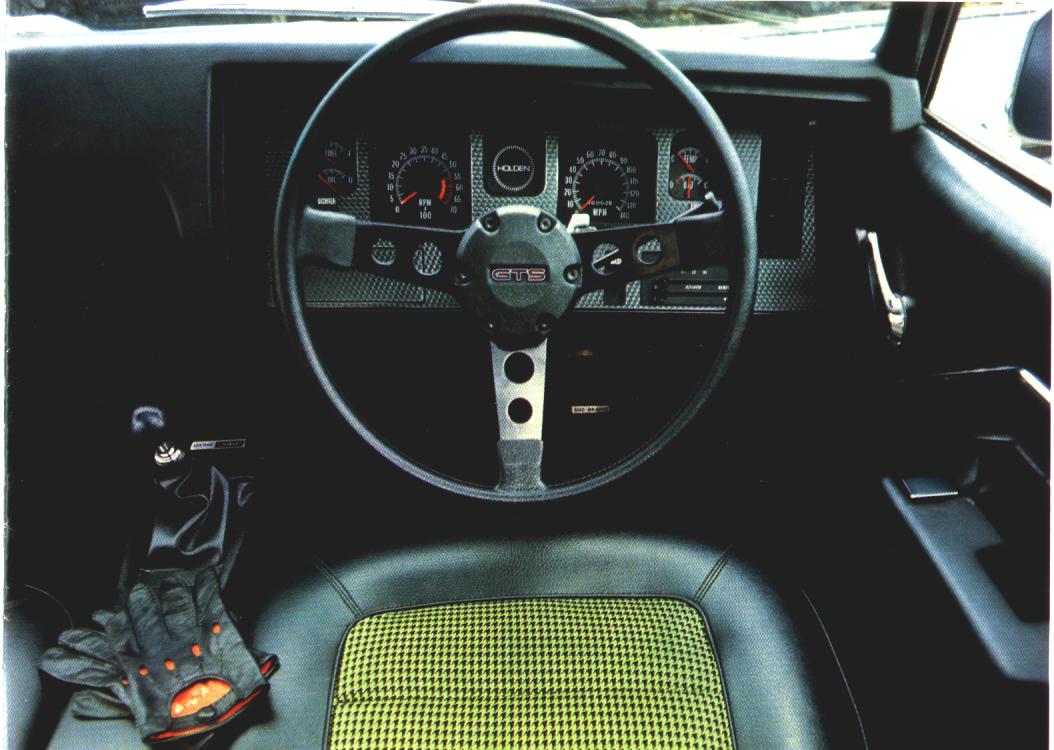
The following option chart is from the Holden HQ catalogue "Holden - The Great way to Move" issued July 1971. It is useful in determining whether your HQ has "official" factory power train options or not.
| Engine | Models with this engine | BHP | Standard Transmission | Optional Transmission | Standard Axle | Performance Axle | Economy Axle |
| 173 CI 6-cyl | Standard on Belmont, | 118 | 3-speed manual | 3.55 | 3.90 | 3.36 | |
| Kingswood & Monaro | 4-speed manual | 3.55 | 3.90 | 3.36 | |||
| Tri-matic auto | 3.36 | 3.55 | - | ||||
| 202 CI 6-cyl | Standard on Premier & | 135 | 3-speed manual | 3.55 | - | 3.36 | |
| Monaro LS, optional on | 4-speed manual | 3.55 | 3.55 | 3.36 | |||
| Belmont, Kingswood & | Tri-matic auto | 3.36 | 3.36 | - | |||
| Monaro | |||||||
| 253 CI V8 | Standard on Monaro GTS, | 185 | 3-speed manual | 3.08 | 3.36 | - | |
| option on all other models | (except GTS) | ||||||
| 4-speed manual (on GTS) | 4-speed manual | 3.36 | 3.55 | - | |||
| High performance | 3.36 | 3.55 | - | ||||
| 4-speed manual | |||||||
| Tri-matic auto | 2.78 | 3.08 | - | ||||
| 308 CI V8 | Option on all models | 240 | High performance | 3.36 | 3.55 | 3.08 | |
| 4-speed manual | |||||||
| Tri-matic auto | 2.78 | 3.36 | 3.08 | ||||
| (3.36 standard on GTS) | |||||||
| 350 CI V8 | Option on Monaro GTS & | 275 | High performance | 3.08 | 3.55 | - | |
| Monaro LS | 4-speed manual | 3.36 | |||||
| (available only on GTS) | |||||||
| Turbo-Hydramatic | 3.08 | - | 2.78 |
ENGINES
up to 30-9-72
L20 202HC
L30 350
L31 308
L32 253HC
from 1-10-72
D 173HC
L 202HC
R 253HC (4.2 litre)
T 308 (5.0 litre)
U 350
ENGINE SPECIFICATIONS
173 ci (2850cc) available in Monaro onlySix cylinder inline front mounted
OHV 2 valves per cylinder cast iron head/block
Bore and stroke:3.5 inches (85.75 mm) x 3.0 inches (88.9 mm x )
Single barrel Bendix Stromberg downdraught carburettor
Power output (DIN):118 bhp (88 kW) at 4400
Torque (DIN):168 lb/ft (226.8 Nm) at 2000
Compression ratio:9.4:1
202 ci (3300cc) Standard in LS, optional in Monaro
Six cylinder inline front mounted
OHV 2 valves per cylinder cast iron head/block
Single barrel Bendix Stromberg downdraught carburettor
Bore and stroke:3.625 inches (88.8 mm) x 3.25 inches (82.5 mm)
Power output (DIN):135 bhp (100 kW) at 4400 rpm
Torque (DIN):194 lb/ft (261.9 Nm)at 2000
Compression ratio:9.4:1
253 ci (4150cc) Standard in GTS, optional in Monaro and LS
V8 front mounted
OHV 2 valves per cylinder cast iron head/block
Twin barrel Bendix Stromberg downdraught carburettor
Bore and stroke:3.625 inches (88.8 mm) x 3.062 inches (75.0 mm)
Power output (DIN):185 bhp (138 kW) at 4400 rpm
Torque (DIN):262 lb/ft (353.7 Nm) at 2400 rpm
Compression ratio:9.0:1
308 ci (5050 cc) Optional in all models
V8 front mounted
OHV 2 valves per cylinder cast iron head/block
Four barrel Rochester downdraught carburettor
Bore and stroke:4.0 inches (101.6 mm) x 3.062 inches (75.0 mm)
Power output (DIN):240 bhp (179.0 kW) at 4800 rpm
Torque (DIN):315 lb/ft (425.2 Nm) at 3000 rpm
Compression ratio:9.0:1
350 ci (5740 cc) Optional in LS and GTS only
V8 front mounted
OHV 2 valves per cylinder cast iron head/block
Four barrel downdraught Rochester carburettor
Bore and stroke:4.0 inches (101.6 mm) x 3.480 inches (85.26 mm)
Power output (DIN):275 bhp (205.1 kW) at 4800 rpm
Torque (DIN):360 lb/ft (486 Nm) at 3200 rpm
Compression ratio:8.5:1
TRANSMISSIONS
Six cylinder and 253 V8Three speed all synchro manual.
1st:3.07:1
2nd:1.68:1
3rd:1.00:1
Reverse:3.59:1
M20 Six cylinder and 253 V8
Four speed all synchro manual.
1st:3.05:1
2nd:2.19:1
3rd:1.51:1
4th:1.00:1
Reverse:3.05:1
M21 308 V8
Four speed all synchro manual.
1st:2.54:1
2nd:1.83:1
3rd:1.38:1
4th:1.00:1
Reverse:2.54:1
MC7 350 V8
Muncie Four speed all synchro manual
1st:2.52:1
2nd:1.88:1
3rd:1.46:1
4th:1.00:1
Reverse:
M40 Three speed Trimatic automatic
1st:2.31:1
2nd:1.46:1
3rd:1.00:1
Reverse:1.85:1
M41 Three speed Turbo Hydra-Matic 400
1st:2.48:1
2nd:1.48:1
3rd:1.00:1
Reverse:2.08:1
DIFFERENTIAL RATIOS
BANJO
G90………………3.90:1
G91………………3.55:1
G93………………3.08:1
G95………………3.36:1 (standard on SS and optional on GTS)
SALISBURY
GV1……………….3.08:1
GV2……………….3.36:1 (standard on SS and optional on GTS)
GV3……………….2.78:1 (optional on trimatic)
GV4……………….3.55:1
SUSPENSIONFront:Independent, coil springs, upper and lower Actuating arms, anti roll bar, telescopic dampersRear Live axle, four link system, coil springs, telescopic dampers BRAKESFront:Disc. Power assisted ventilated discs standard with all V8s and LS. Optional on all other modelsRear:Drum WHEELSMonaro - 5.00JJx14Monaro LS - 5.00JJx14 Monaro GTS - 6.00JKx14 DIMENSIONSTotal length (inches/mm):187.5 inches (4761 mm)Total width (inches/mm):74.0 inches (101.6 mm) inches Total height (inches/mm) at kerb weight:53.1 inches (1348 mm) Wheelbase (inches/mm):111 inches (2719.5 mm) Front track (inches/mm):60.2 inches (1529 mm) Rear track (inches/mm):60.2 inches (1529 mm) Fuel tank capacity:14.5 gallons (65 litres) Kerb weight (lb/kg): Monaro and Monaro LS Coupe - 2950 lbs (1339.3 kg). Monaro GTS - 3150 lbs (1451 kg) Turning circle kerb to kerb (inches/mm):39 ft (11.9 m) |
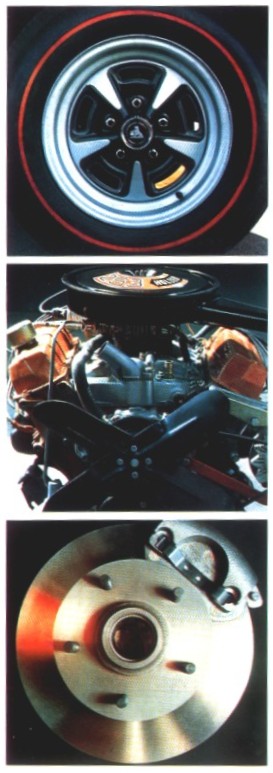 |
ENGINE NUMBERS
Stamped on a pad at the front of the right hand cylinder bank.The prefixes for the HQ GTS 350 Monaro coupe or sedan is 'QU'.
BODY/CHASSIS NUMBERS
Stamped on a plate attached to the right hand side of the firewall.Up until October 1 1972 the first five numbers of the 13 digits was the model number.
80337 - Monaro Coupe
80437 - Monaro Coupe
80837 - Monaro GTS Coupe
81837 - Monaro GTS 350 Coupe
The next letter is the series code: Q for HQ Monaro
The next two digits are a indicating the plant where the vehicle was built
H1-H4 - Brisbane
H5-H9 - Sydney
J1-J9 - Melbourne
L1-L5 - Adelaide
L6-L9 - Perth
Next is the vehicles serial number represent the sequence in which the vehicle was built at that particular plant.
After October 1 1972 the number system was changed. The first four digits are the model number:
8P37 - Monaro LS Coupe
8Q69 - Monaro GTS Sedan
8Q37 - Monaro GTS Coupe
The next letter is the engine identification:
E - QE 173 (low compression 2850 cc)
D - QD 173 (high compression 2850 cc)
M - QM 202 (low compression 3300 cc)
L - QL 202 (high compression 3300 cc)
S - QS 253 (low compression 4.2 litre)
R - QR 253 (high compression 4.2 litre)
T - QT 308 (high compression 5.0 litre)
The next letter is the model year:
D - 1974
E - 1975
F - 1976
G - 1977
H - 1978
J - 1979
The next two digits is the assembly plant code:
H1-H4 - Brisbane
H5-H9 - Sydney
J1-J9 - Dandenong
L1-L5 - Adelaide
Next is the vehicles serial number which represents the sequence in which the vehicle was built at the particular plant. The final letter is the series code: Q for HQ
OTHER IDENTIFICATION MARKS
GTS 350 - 'GTS' and 'Monaro' badges. Headlight bezels, grille, under front and rear bumpers, along sill panels and rear of boot lid blacked out. Three horizontal louvres in lower front guards.
Holden HQ Monaro GTS: Peter Brock - TV commercial
